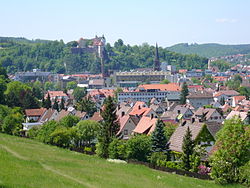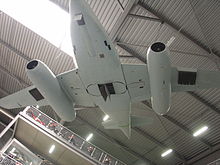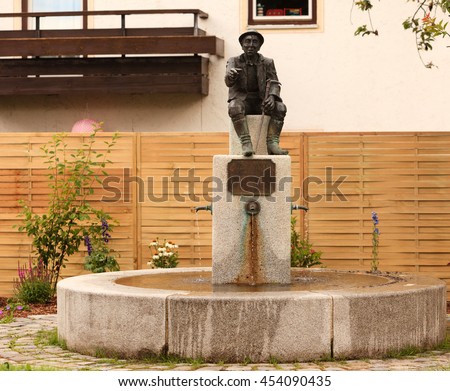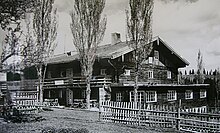
DACHAU KZ - SATELLITE CAMPS -
Alphabetical Order
H
HAUSHAM
From 1942 until the war ended male prisoners from Dachau and women from the concentration camp - "Ravensbrück, were used as forced labour for the SS-Recreation Home (Erholungsheim) on the neighbouring farm which is recorded in the reports as a working commando of the German Experimental Centre for Nutrition and Catering Company (DVA) (GmbH), with up to ten women prisoners (Jehovah's witnesses) who the SS brought here to their advantage for "the safe use of Bible Students' for which they were known for. The reason why the E&R hold some women prisoners is striking in that, that, the farm - as in the official correspondence - described it, as "experimental farm", nor do reports from the DVA (Deutsche Versuchsanstalt) indicate no experiments on animals, but only mentioners the usual care of cows, horses, pigs and chickens, other than mucking out the stables and the laborious hay-making, up on mountain meadows.Two women had to fell a tree and saw by hard in the winter of 1944, a tree with a handsaw.
Haushan - Bavaria, Germany
The title of the two properties, which already existed during the 17th century, dated back to the first owner Georg Eckard. A tourist club, after the purchase, converted the lower Bauernhaus (Farm-House) which they re-named 'Vordereckart' into a 'workers rest-home in 1924 after the purchase, and called it "Rohrauerhaus" after its co-founder, who was banned in 1933 and the home was occupied by an SA detachment. A Munich police officer bought the house , but the Bavarian state had it expropriated on August 6, 1934, and later let it on a lease-hold basis to the Dachau concentration camp, which changed it to be the "SS Kameradschaftsheim-Vordereckart". A former prisoner, said that he had in 41 or 42 with ten to twelve other prisoners, worked on the building to upgrade the property to a recreation centre for higher personalities of the SS. In 1944, the KZ administration received a building permit from the district council of Miesbach for a 32 square meter 'Kleintierstallung' for an «SS Kameradschaftsheim» - in the application form one correctly gave the required workers as «prisoners KZ Dachau». On April 16, 1944, the authorities were informed of the beginning of the construction and that "prisoners" carried out the masonry and carpentry works. Furthermore, on the 27th of May 1944 the completion of the construction by four prisoners who laid a water pipe in 1944/45 and began to build an air raid shelter. They were housed in a "stable-like building", and had "a lot of freedom" with only one guard post. Up to 14 male prisoners - mostly craftsmen - were all employed in Hausham, the sub-camp for men
According to the ITS-Index from 9 July 1942 to 25 April 1945.
After the outbreak of war, the SS leased the neighbouring farm, Hintereckart, and had it managed by concentration camp detainees for the DVA. The area was surrounded with guard d posts in order not to disturb the Research Institute in its scientific work. It was speculated that the SS experimental institute had used female concentration camp prisoners as experimental objects. According to the ITS directory, Hausham camp was used for women from 1944 to April 25, 1945 under the administration of Dachau.. At that time the Dachau allocation method fell into the era of the restructuring of the sub-camp system for female prisoners, which began in September 1944. The first female prisoners from the concentration camp of Ravensbrück, however, were already in January 1942 there, and used immediately to remove snowfalls (Schneeschafeln) on the Eckart. Of the eight to ten women, two to three of them were employed as household- and kitchen maids in the SS-Erholungsheim (Recreation-Home) Vordereckart in the course of time, while the others worked at the Hintereckart farm. A total of ten prisoners are known by name - one Belgian, two Polish, three German and four Dutch, were Witnesses of Jehovah. They became entitled various privileges and were allowed to wear civilian clothes. The administrator silently tolerated illegal visits by relatives. Exchanges of letters and the celebration of the annual holy supper of the Lord of the faith - even with red wine - and home-made unleavened bread were provided. They also secretly read the Bible and met on Sundays with local religious brothers in the nearby forest. After the women had complained to the inspecting SS officer from the main camp, about the harassment they received from the assigned SS-Aufseherin (female guard) , who regularly came to the farm with a delivery truck with the provisions, the Aufseherin was replaced by an elderly SS warden and took over the 'guarding' often he even helped with the work to be completed. In the hierarchy of the SS leadership there was a political prisoner, with a certain amount of freedom, who made repairs, whatever was necessary around the properties. Apart from food, these two from the Dachau came with clothes and even greetings from other imprisoned biblical scholars. Once they carried a written message and the forbidden 'Watchtower' booklet intended for the Jehovah's Witness on the farm. With the food delivered from the KZ-Dachau contained Blutwurst (blood sausages), which they refused to eat for religious reasons, although the women were allowed to eat by themselves, all Biblical scholars were eating and spending the night in the rooms on the farmhouse.
According to
the reports of the sub-camps of the KZ-Dachau
for Hausham for April 1, 1945, there were
four men and ten women, and on 26 April 1945
four men and nine women present.
American troops liberated the women on 19 April 194. With the end of war the owner no longer allowed the prisoners to stay on the farm. Before they travelled to their homeland on May 8, 1945, they thanked the administrator with a letter for their treatment, "which made our forced existence more bearable"
On October 1, 1947, the Tourist Association once again became a legal owner of Vordereckart. 'Rohrauerhaus' was rebuilt as a modern recreation centre in 1965/66. Since 1974, the state capital of Munich has now been the owner and has maintained a Schullandheim (school country house). The former 'test facility' at Hintereckart is of today still in private ownership.
On the properies there is no sign in memory of the prisoners held there.
Author German Text: Johannes Wrobel
HEIDENHEIM AN DER BRENZ
There is evidence that human life existed within the city limits of Heidenheim as far back as 8,000 years ago. However, a permanent settlement was not established until approximately 1300 BC. Extensive ruins remain of settlements dating, predominantly, to the period from 1200 to 800 BC.
The sub-camp Heidenheim at the north-eastern end of the Swabian Alb in Ostwürtenberg was presumably established on 20 October 1941. The commander of the local police school, Police Major Petrash, had ordered fifty prisoners from the KZ-Dachau to the work for the school could not be carried out, which had been drawn up since the summer of 1939, but as a result of the general labor shortage, and never be be completed. The construction of the 'Sclosshau' settlement in the neighbourhood of the school, which had been planned as a residential complex for police officers and their families (nine buildings with 33 dwellings), thus the laying of the necessary sewage connections, due to the tomography and the location of the police school on a mountainous terrain, and elaborately designed, plus the construction of a two-wheeled, 300-meter-long machine-gun shooting-track in the woods of the police school. Technically speaking these prisoners were the responsibility and cam thereby inder the supervision of the Ulmer construction company Rapp & Schüle. In addition, the prisoners had to clear snow on city streets.
.The prisoners were housed in a wooden barrack, located behind one of the school buildings of the school. Barracks and a small grassy area, which served as an apartment, were surrounded with a simple barbed wire fence. The police were exclusively used as guar ds. There was only one single SS-man at the place. He was a Kommandofüjrer from Dachau.
American troops liberated the women on 19 April 194. With the end of war the owner no longer allowed the prisoners to stay on the farm. Before they travelled to their homeland on May 8, 1945, they thanked the administrator with a letter for their treatment, "which made our forced existence more bearable"
On October 1, 1947, the Tourist Association once again became a legal owner of Vordereckart. 'Rohrauerhaus' was rebuilt as a modern recreation centre in 1965/66. Since 1974, the state capital of Munich has now been the owner and has maintained a Schullandheim (school country house). The former 'test facility' at Hintereckart is of today still in private ownership.
On the properies there is no sign in memory of the prisoners held there.
Author German Text: Johannes Wrobel
HEIDENHEIM AN DER BRENZ
There is evidence that human life existed within the city limits of Heidenheim as far back as 8,000 years ago. However, a permanent settlement was not established until approximately 1300 BC. Extensive ruins remain of settlements dating, predominantly, to the period from 1200 to 800 BC.
The sub-camp Heidenheim at the north-eastern end of the Swabian Alb in Ostwürtenberg was presumably established on 20 October 1941. The commander of the local police school, Police Major Petrash, had ordered fifty prisoners from the KZ-Dachau to the work for the school could not be carried out, which had been drawn up since the summer of 1939, but as a result of the general labor shortage, and never be be completed. The construction of the 'Sclosshau' settlement in the neighbourhood of the school, which had been planned as a residential complex for police officers and their families (nine buildings with 33 dwellings), thus the laying of the necessary sewage connections, due to the tomography and the location of the police school on a mountainous terrain, and elaborately designed, plus the construction of a two-wheeled, 300-meter-long machine-gun shooting-track in the woods of the police school. Technically speaking these prisoners were the responsibility and cam thereby inder the supervision of the Ulmer construction company Rapp & Schüle. In addition, the prisoners had to clear snow on city streets.
.The prisoners were housed in a wooden barrack, located behind one of the school buildings of the school. Barracks and a small grassy area, which served as an apartment, were surrounded with a simple barbed wire fence. The police were exclusively used as guar ds. There was only one single SS-man at the place. He was a Kommandofüjrer from Dachau.
At this sub-camp there were mainly skilled
professions that were needed for the work to be
carried out: bricklayers, heating engineers,
Roofing specialists, Electricians, Tilers andÂ
Painter.s Also gardeners, according to estimation
of a former prisoner about 15 to 20 professionals
were present in addition to unskilled inmates that
were employed as helpers. (Hilfsarbeiter)
There were two Kapos, one for the outside and one for the inside work, and one care-giver (Pfleger). All the prisoners were termed as German 'pokitical' elements.. Only three of the 50 male prisoners were not 'Reds'. There was a 'Greener'(criminal), a 'Black'(meaning an 'asocial'Â and a hairdresser with a red rt-angle, who also functioned as the 'cleaner' for the commanding officer. The sub-camp, with the exception of six Poles and one Slovenian, consisted only of Germans, which is probably due to the fact that, according to the statements of various prisoners, it was regarded as a 'gutes' (good) sub-camp and the detainee work statistic of Dachau indicates this.
According to the latest reports, there was only one change in the composition of camp administration, until it'sclosure. When the commander went on vacation in April 1942, he took with him back to Dachau, three prisoners, two Germans and one Pole, the Pole, because he was to be released for unknown reasons, the Germans because they had suffered injuries, thus were considered useless for any work. The relieving SS-deputy brought as a replacement three more Poles from Dachau. The strength of the sub-camp thereby remained the same. The two casualties were later to have perished in Dachau hospital. In Heidenheim itself there were no deaths.

Hildesheim an der Brenz
There were two Kapos, one for the outside and one for the inside work, and one care-giver (Pfleger). All the prisoners were termed as German 'pokitical' elements.. Only three of the 50 male prisoners were not 'Reds'. There was a 'Greener'(criminal), a 'Black'(meaning an 'asocial'Â and a hairdresser with a red rt-angle, who also functioned as the 'cleaner' for the commanding officer. The sub-camp, with the exception of six Poles and one Slovenian, consisted only of Germans, which is probably due to the fact that, according to the statements of various prisoners, it was regarded as a 'gutes' (good) sub-camp and the detainee work statistic of Dachau indicates this.
According to the latest reports, there was only one change in the composition of camp administration, until it'sclosure. When the commander went on vacation in April 1942, he took with him back to Dachau, three prisoners, two Germans and one Pole, the Pole, because he was to be released for unknown reasons, the Germans because they had suffered injuries, thus were considered useless for any work. The relieving SS-deputy brought as a replacement three more Poles from Dachau. The strength of the sub-camp thereby remained the same. The two casualties were later to have perished in Dachau hospital. In Heidenheim itself there were no deaths.

Hildesheim an der Brenz
Responsible for the camp, as
SS-Leader, was Oberscharführer-since May-
Josef Ruder. From
April 1934 he had been a member of the
KZ-Daxchau's guard detachnent, and among
other things managed the 'Pfefferrmühle'
(Pepper Mill) at the 'Plantage' in Dachau,
while Heidenheim was his
only independent sub-camp he had ever
directed. In a
denazification procedure in 1948, he
received only a fine. Two former prisoners from Dachau
had allegedly spoken up for him.
Severe ill-treatment, punishment or criminal complaints according to Dachau regarding Heidenheim are not known. The locaton, far from the main camp, the small commandos, and the food supply provided by the police school, improved the conditions for the prisoners. The morning roll-call lasted only a few minutes, and no Appell took place at noon in the evening. Ruder stood only at the entrance gate and counted the prisoners like a herd of sheep, which is driven into the pen. They stayed outside their huts after working hours in groips, relaxed and conversed. Ruder was quartered in the upper storey of the garrison building opposite the camp, which was somewhat lower situated , so that he could look up at eye level over the camp, but hardly ever intervened. If an inmate had to go to the doctor or dentist, because the male nurse could not help with his restricted abilities, the 'patient' was occasionally led by Ruder personally into the city. The prisoners were given the same food as the police cadets in their canteen. When the chef attempted to shorten the bread aloowance (a loaf from three, as in Dachau to four days per inmate), Ruder had to point out to a reference in the contract with Rapp & Schüle, who actually employed the prisoners.
On the topic of resistance there is the statement of the Slovenian prisoner that he had worked at the construction of the shooting range, which required extensive earthworks so that he was in a position to remove a security mechanisim which ensured the safety of the lorry which was used as transport for earth soil on steel cables alomg the steep terrain. The steel rope, which secured a small lorry, suddenly gave way, so that the tractor and the lorry rushed uncontrollably at the steep slope, and finally crashed. Whether the motive was targeted sabotage or a desire for an unscheduled work break remains unresolved.
There is a sports facility now on the premises. Nothing reminds one of the prisoners that were once kept there.
Author German Text: Alfred Hoffmann
HORGAU
The KZ-sub-camp Horgau was first mentioned on the 4th March 1945. At this point it had been in it's existence in a matter of weeks. Prisoners worked there in a sheet metal-stamping workshop for Messerschmitt AG, and was built to camouflage it in the forest near Horgau railway station.The site is about 15 kilometers west of Augsburg.The sub camp and the factory formed a combined unit. The 'Waldwerk' (Forest Factory) was built on 15 September 1944 and erected on 1 March 1945 by 80 workers, including
probably a working commando from the sub-camp Augsburg-Pfersee.
307 prisoners from the KZ-Bergen-Belsen and two from the KZ-Dachau had been transported to Horgau. Whether more than these 307 prisoners were in the camp, could not be clarified. The planned expansion to 700 prisoners was probably never achieved. Among the KZ prisoners were mainly Nationals from Poland and the Soviet Union, but also Germans, Italians, Frenchmen and Hungarians, including a large number of Jews. The span of the birth years, as an average as to age,started from 1906 to 1927.
Wing span attached to ME262
Continued under Part 7
Severe ill-treatment, punishment or criminal complaints according to Dachau regarding Heidenheim are not known. The locaton, far from the main camp, the small commandos, and the food supply provided by the police school, improved the conditions for the prisoners. The morning roll-call lasted only a few minutes, and no Appell took place at noon in the evening. Ruder stood only at the entrance gate and counted the prisoners like a herd of sheep, which is driven into the pen. They stayed outside their huts after working hours in groips, relaxed and conversed. Ruder was quartered in the upper storey of the garrison building opposite the camp, which was somewhat lower situated , so that he could look up at eye level over the camp, but hardly ever intervened. If an inmate had to go to the doctor or dentist, because the male nurse could not help with his restricted abilities, the 'patient' was occasionally led by Ruder personally into the city. The prisoners were given the same food as the police cadets in their canteen. When the chef attempted to shorten the bread aloowance (a loaf from three, as in Dachau to four days per inmate), Ruder had to point out to a reference in the contract with Rapp & Schüle, who actually employed the prisoners.
On the topic of resistance there is the statement of the Slovenian prisoner that he had worked at the construction of the shooting range, which required extensive earthworks so that he was in a position to remove a security mechanisim which ensured the safety of the lorry which was used as transport for earth soil on steel cables alomg the steep terrain. The steel rope, which secured a small lorry, suddenly gave way, so that the tractor and the lorry rushed uncontrollably at the steep slope, and finally crashed. Whether the motive was targeted sabotage or a desire for an unscheduled work break remains unresolved.
In a tiled stove of the
Schlosshau settlement, a wall tile was
found in 1980 hidden istalled there by
three prisoners (stove setter, painter
and tiler). Under
the heading 'document' they made a
reference to their imprisonment. [It
was probably intended as a
tine-capsule,sic]
In the middle of December 1944 a
barrack on the grounds of the police
ground of Heidenheim was again occupied by
a KZ-sub camp, this time the evacuees from
KZ-Natzweiler.There is a sports facility now on the premises. Nothing reminds one of the prisoners that were once kept there.
Author German Text: Alfred Hoffmann
HORGAU
The KZ-sub-camp Horgau was first mentioned on the 4th March 1945. At this point it had been in it's existence in a matter of weeks. Prisoners worked there in a sheet metal-stamping workshop for Messerschmitt AG, and was built to camouflage it in the forest near Horgau railway station.The site is about 15 kilometers west of Augsburg.The sub camp and the factory formed a combined unit. The 'Waldwerk' (Forest Factory) was built on 15 September 1944 and erected on 1 March 1945 by 80 workers, including
probably a working commando from the sub-camp Augsburg-Pfersee.
307 prisoners from the KZ-Bergen-Belsen and two from the KZ-Dachau had been transported to Horgau. Whether more than these 307 prisoners were in the camp, could not be clarified. The planned expansion to 700 prisoners was probably never achieved. Among the KZ prisoners were mainly Nationals from Poland and the Soviet Union, but also Germans, Italians, Frenchmen and Hungarians, including a large number of Jews. The span of the birth years, as an average as to age,started from 1906 to 1927.
The 'Waldwerk'
Horgau was part of the production program of the jet engine ME
252.. Production started in March 1945. About 250 aircraft wings
should have been produced. In addition to this work at
Messerschmitt, some of the prisoners were also involved in road
leveling and work for the Reichsbahn (Railway).


The barracks
of the Waldwerk (forest factory) and the camp were well
camouflaged to protect them against air raids. On the roofs grew
trees and bushes, furthermore the location of the huts was
adapted to the forest terrain. Only a few barracks with heavy
machinery installed had concrete flooring, the others with
simple hardened clay covered with a Lino-type material.
Accommodation and sanitary facilities were accordingly
primitive. Today, only a few remains of the buildings are in the
forest and can be viewed as to their simple construction.
In addition to the more than 300 prisoners, civilian forced laborers, male and females, were also working at the factory, who were housed near the Horgauer railway station. In a restaurant nearby there was the kitchen for the sub-camp. In spite of the relative large size, the company was able to operate in complete secrecy. The Wachmannschaft (guardsmen) were composed of SS men and members o the Wehrmacht, unable fpr front line duties. Camp Horgau was administered by the sub camp Augsburg-Pfersee. Whether or not there were deaths in Horgau and how the prisoners' living conditions were concerned, is not known.

As the
US army approached, the camp in was disbanded on 4 April
1945 and the prisoners were transported to Augsburg-Pfersee.
During the Dachau trials, the sub camp Horgau
was singularly mentioned. In 1967,
the central office of the Justice Administration in
Ludwigsburg, undertook investigations, these were passed to
the Srtaats-Anwaldschaft Munich and closed them without
charges against any individual being brought
Author German Text: Wolfgang Kucera
In addition to the more than 300 prisoners, civilian forced laborers, male and females, were also working at the factory, who were housed near the Horgauer railway station. In a restaurant nearby there was the kitchen for the sub-camp. In spite of the relative large size, the company was able to operate in complete secrecy. The Wachmannschaft (guardsmen) were composed of SS men and members o the Wehrmacht, unable fpr front line duties. Camp Horgau was administered by the sub camp Augsburg-Pfersee. Whether or not there were deaths in Horgau and how the prisoners' living conditions were concerned, is not known.

Author German Text: Wolfgang Kucera
Acknowledgements:/Sources:
Wikipedia,
Der Ort des Terrors, Vol.:2-page 283
Verlag C.H.BeckMünchen 2005
Translated from German by:
Herbert Stolpmann von Waldeck
dtolpmann@gmail.com
Continued under Part 7



No comments:
Post a Comment
Note: Only a member of this blog may post a comment.